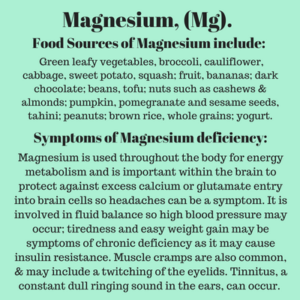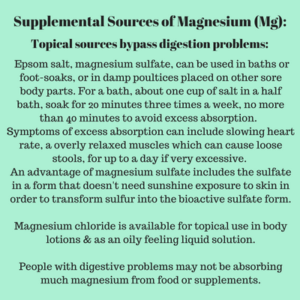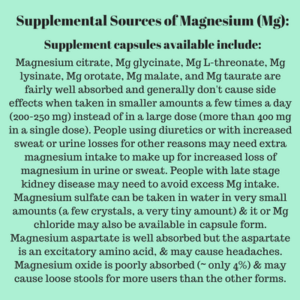The last post got a little long and it included a link to another health writer who was summarizing a large amount of material on the topic of demyelination – it is amazing what you can learn by reading. I only mentioned the article, (22), briefly because it was already a long post and I hadn’t checked the other writer’s references, (it is primarily all medical research from peer reviewed journals (22.1)); and some of his recommendations are not typical, however I had read of them elsewhere so it seemed thorough and well written. The truly intriguing part for me was just how many other conditions there are that may be susceptible to demyelination and increased negative symptoms due to nerve degeneration.
I have a few of the problems that were mentioned and I have had early symptoms of nerve numbness and pain in my extremities – fingertips particularly. Health is easier to maintain then to restore once chronic conditions develop. I have managed to reverse the nerve numbness and occasional pain that I was having in my fingertips but it is with several daily or weekly health habits, not just a simple take-this-medication-once-a-day solution.
The list of psychiatric conditions that may also have demyelination summarized in an article about possible ways to regenerate myelin, (22):
- Attention deficit hyperactivity disorder
- Depression
- Bipolar disorder
- Dyslexia
- Language disorders
- Stuttering
- Autism
- Obsessive-compulsive disorder
- Cognitive decline
- Alzheimer’s disease
- Tourette’s syndrome
- Schizophrenia
- Tone deafness
- Pathological lying
- (22)
That is quite a list – protect your oligodendrocytes, because they protect your ability to think and communicate, to control your ability to control your movements and to have stable moods, reduce anxiety, and control your ability to be able to read and speak and to be able to control your impulses and ability to prevent yourself from lying or saying things you don’t intend to say, and to be able to understand that your thoughts are your own thoughts, and to be able to hear accurately. The reference given for the information is this article: [45].
Neurology is the study of the nervous system, Psychiatry or Psychology is the study of mental health and neuropsychiatry is the study of mental symptoms caused by neurological conditions.
This topic of psychiatric conditions and other conditions that may also have demyelination is also reviewed in a summary of Neurotoxicology for neurologists: (6.Neurotoxicology). Neurology is the study of the nerves and nervous system. The nervous system includes the brain and spinal cord and all of the nerves throughout the body. It is subdivided into two main categories: the Central Nervous System (CNS) refers to the brain, the spinal cord and nerves of the brain and spinal cord; and the Peripheral Nervous System (PNS) refers to the nerves throughout the rest of the body. Neurologists are medical doctors who specialize in conditions affecting the nervous system. They may focus on a subspeciality within the field of neurology (What is a neurologist?, HealthLine) Interestingly dementia, chronic headaches, and Multiple sclerosis are mentioned as possible conditions they treat but all the other psychiatric conditions mentioned in the list that may involve demyelination are not mentioned.
The overview article on Neurotoxicology does mention that psychiatric symptoms may occur in patients with neurological conditions but that the symptoms tend to be dismissed by neurologists, and are not studied in depth, so more reliable information is needed about psychiatric symptoms presenting with neurological disorders – see “Psychiatric and behavioural disorders.” (6.Neurotoxicology) An article for neurologists goes into more detail about psychiatric symptoms that might deserve consultation with a neurologist rather than having the patient only see a psychiatrist: Neurological syndromes which can be mistaken for psychiatric conditions. Early symptoms of Multiple sclerosis for example sometimes may be mistaken for a psychiatric condition. (Neurological syndromes) Talk therapy or psychiatric medications are not going to help a patient regenerate their myelin after all. Neuropyschiatrists are neurologists that also have a degree in psychology and specialize in treating patients with mental health and behavioral symptoms related to neurological disorders. (neuropsychiatrists)
PTSD was also mentioned as a psychiatric condition that may have demyelination.[45]
Reading the article that was referenced for the list of psychiatric conditions that may also have demyelination [45] provided an additional condition that was not added to the list in the summary article about potential ways to help regenerate myelin (22) – PTSD also may involve demyelination, and confirmed the rest of the list were mentioned [45] . The article also includes more background information about the function and development of the myelin sheath in learning and behavior.
Nerves with myelin provide a much faster signal and oligodendrocytes myelinate several different nerves so there is additional benefit in signals that work in a coordinated manner to also improve speed of function. The myelination occurs over time so the phrase practice, practice, practice applies. Peak time of life to learn skills is in our youth because that is when the majority of myelination occurs -starting in early childhood and continuing until the early twenties even up to age thirty. Healing after injury or learning a new skill later in life would still require the practice, practice, practice so the speedy pathways between groups of nerve cells develop their myelin sheaths in coordinated connections. [45]
This information may help show the difficulties faced by people with PTSD or other psychiatric conditions – the brain connections are coordinated in patterns learned from traumatic memories or are stuck in Obsessive Compulsive patterns. The problem with impulse control might also make more sense if there is simply “leaky” wiring in the brain. Signals that were intended to do one thing might end up activating other behaviors because the myelin sheath is no longer functioning as expected.
A cognitive therapy technique, involving frequent practice/repetition of new ways to talk to yourself – it might help strengthen more positive neural networks with new myelin sheath connections.
Learning new patterns of thinking, replacing traumatic or anxious thoughts that were learned as a child or during a traumatic phase of life can take time and a lot of repetition but it is possible, just like it can be possible to relearn how to walk or do other basic life skills after a stroke or traumatic physical injury. A book by Shad Helmstetter, PhD discusses how to rephrase your own internal self talk to be more positive and gives examples for a number of different types of concerns. I found the technique helpful for emotional overeating and share phrases that I wrote regarding healthy eating and lifestyle and a link to the book in a previous post: “What to Say When You’re Talking to Yourself.” The recommendation that I followed was to read the statements several times every day – for a while, months even. I don’t remember how long I read them daily but it was for quite a while and I still have the little ring binder of statements that I wrote.
Often changing behavior patterns is easier when the new pattern is created first, rather then trying to stop the old first. Build the new and then the old is no longer needed. Addition, I found the source of that idea:
“The secret of change is to focus all of your energy not on fighting the old, but on building the new.” – Socrates
A new way to think about demyelination – what is the underlying problem? Possibly excess cell death, at rates above the ability to breakdown and remove nucleotides (ATP, ADP, UTP, UDP).
The article on demyelination and cognitive disorders, [45] , also mentioned that adenosine plays a role in signaling oligodendrocytes to make myelin and an article with more information on the topic mentions that increased amounts of ATP, ADP, UTP, UDP can signal breakdown of myelin. Increased presence of those chemicals was suggested to possibly be due to increased cell death without normal clearing away of the old cellular material. And some types of Multiple sclerosis seems to involve increased levels of the enzyme that breaks down adenosine so there would be less available to signal the production of myelin. (8.adenosine in MS)
Take home point – protect against excessive cell death and/or mitochondria damage by not having excessive glutamate (11.link) or aspartate – excitatory amino acids that may be overly available in the modern processed food diet – and by having adequate magnesium to protect the cells from their interior by providing the needed energy to block ion channels in the cell membrane and prevent excessive amounts of calcium, glutamate or aspartate from being able to cross the cell membrane and enter the cell’s interior.
As usual however, it is not that simple, (not that avoiding glutamate and aspartate in the diet is easy, they are in many processed foods), other things can also cause excessive cell death.
- Exposure to toxins in the environment or due to drug use, illicit or legal, can cause excessive cell death and lead to demyelination disorders. An overview:(6.Neurotoxicology)
- Lack of oxygen can also be a cause. Lack of nutrients in general can increase the breakdown of cellular parts to provide enough nutrients however if malnutrition is severe and ongoing the breakdown (autophagy) can become excessive. (7.Metabolic Stress, Autophagy & Cell Death)
- Traumatic injury and infection can increase the rate of cell death above the level that the body’s detoxification systems can cope with clearing away the cellular material. Traumatic injury is associated with increased risk for infection for reasons that are not well understood, the immune system is considered functionally suppressed: (10.Immunobiology of Trauma) Also mentioned briefly in the Skeletal Muscle section of this overview: (6.Neurotoxicology).
- Anything that causes excess oxidative stress may cause increased rates of mitochondria breakdown so protecting against stress is protecting the mitochondria which is protecting the cells. (7.Metabolic Stress, Autophagy & Cell Death) Mitochondria are the main energy producers within cells and make up about thirty percent of the volume of cardiac/heart cells. Other type of mitochondrial problems can also increase risk of their switching from promoting health through energy production into a mode that promotes cell death. One of the roles mitochondria play in normal health is storage of excess intracellular calcium. If the mitochondria become dysfunctional then the extra calcium is released into the cell where it can signal increased activity such as release of cannabinoids from the membranes. (9.mitochondria in CVD)
This is approaching really long again, so I am stopping here for now.
/Disclosure: This information is provided for educational purposes within the guidelines of fair use. While I am a Registered Dietitian this information is not intended to provide individual health guidance. Please see a health professional for individual health care purposes./
- Jordan Fallis, 27 Proven Ways to Promote the Regeneration of Myelin. Feb. 18, 2017, Optimal Living Dynamics, https://www.optimallivingdynamics.com/blog/25-proven-ways-to-promote-the-regeneration-of-myelin (22)
- Reference list: https://www.optimallivingdynamics.com/myelin-references (22.1)
- R. Douglas Fields, White Matter in Learning, Cognition, and Psychiatric Disorders, Trends Neurosci. 2008 Jul; 31(7): 361–370. https://www.ncbi.nlm.nih.gov/pmc/articles/PMC2486416/ [45]
- Neurological syndromes which can be mistaken for psychiatric conditions.
- An Overview of Autism Spectrum Disorder, Heterogeneity and Treatment Options. Neuroscience Bulletin, , Vol 33, Iss 2, pp 183–193, https://link.springer.com/article/10.1007%2Fs12264-017-0100-y (autism link)
- Brian J. Altman, Jeffrey C. Rathmell, Metabolic Stress in Autophagy and Cell Death Pathways. Cold Spring Harb Perspect Biol. 2012 Sep 1;4(9):a008763 http://cshperspectives.cshlp.org/content/4/9/a008763.full (7.Metabolic Stress & Cell Death)
- Marek Cieślak, Filip Kukulski, Michał Komoszyński, Emerging Role of Extracellular Nucleotides and Adenosine in Multiple sclerosis. Purinergic Signal. 2011 Dec; 7(4): 393–402. https://www.ncbi.nlm.nih.gov/pmc/articles/PMC3224637/ (8.adenosine in MS)
- Sang-Bing Ong, Asa B. Gustafsson, New roles for mitochondria in cell death in the reperfused myocardium. Cardiovascular Research, Vol. 94, Issue 2, 1 May 2012, pp 190–196, https://academic.oup.com/cardiovascres/article/94/2/190/268169 (9.mitochondria in CVD)
- Dr. Daniel Remick, pre-ARC Director, Immunobiology of Trauma, pre-Affinity Research Collaborative (ARC), Boston University Medical Center, http://www.bumc.bu.edu/evanscenteribr/files/2009/07/pre-arcimmunologytrauma.pdf (10.Immunobiology of Trauma)
- Howard Prentice, Jigar Pravinchandra Modi, Jang-Yen Wu, Mechanisms of Neuronal Protection against Excitotoxicity, Endoplasmic Reticulum Stress, and Mitochondrial Dysfunction in Stroke and Neurodegenerative Diseases. Oxidative Medicine and Cellular Longevity, Vol. 2015, Article ID 964518, 7 pages,Hindawi.com https://www.hindawi.com/journals/omcl/2015/964518/ (11.link)
- Blaylock, R.L. (1996). Excitotoxins: The Taste That Kills. Health Press. ISBN 0-929173-25-2
- Blaylock, R.L. (a neurosurgeon) podcast Excitotoxins, http://www.blaylockhealthchannel.com/bhc-ep-18-excitotoxins (Excitotoxins podcast)
- Excitotoxicity, Wikipedia, https://en.wikipedia.org/wiki/Excitotoxicity (Excitotoxicity)
- Aspartic Acid, Wikipedia, https://en.wikipedia.org/wiki/Aspartic_acid (Aspartic Acid/Aspartate)



